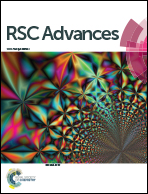Enhanced dechlorination performance of 2,4-dichlorophenol by vermiculite supported iron nanoparticles doped with palladium†
Abstract
In this study, environment-friendly vermiculite (VMT) was used to support nanoscale zero-valent iron (nZVI) and nZVI doped with palladium (abbreviated as Fe-VMT and Pd/Fe-VMT, respectively). The physicochemical properties of the products obtained were analyzed by X-ray diffraction (XRD), specific surface area (BET), scanning electron microscopy (SEM), transmission electron microscopy (TEM) and X-ray photoelectron spectroscopy (XPS). The results showed that the BET surface areas of Fe-VMT and Pd/Fe-VMT were 39.5 m2 g−1 and 59.1 m2 g−1, and 18.9 m2 g−1 for unsupported nZVI nanoparticles. The presence of vermiculite led to a decrease in the aggregation of nZVI and Pd/Fe as observed by SEM and TEM. Batch experiments were conducted to investigate the catalytic performance of nZVI, Pd/Fe, VMT, Fe-VMT and Pd/Fe-VMT via the dechlorination reaction of 2,4-dichlorophenol (2,4-DCP). The dechlorination rates of 2,4-DCP by Pd/Fe-VMT (by adding Pd) were greater than that achieved by Fe-VMT. Additionally, the dechlorination of 2,4-DCP by Pd/Fe-VMT would be influenced by temperature, initial pH values, Pd loading, initial concentration of 2,4-DCP and the dosage of materials. It was confirmed that the ultimate reduction product of 2,4-DCP was phenol. Overall, Pd/Fe-VMT is a promising material for the dechlorination of 2,4-DCP.


 Please wait while we load your content...
Please wait while we load your content...